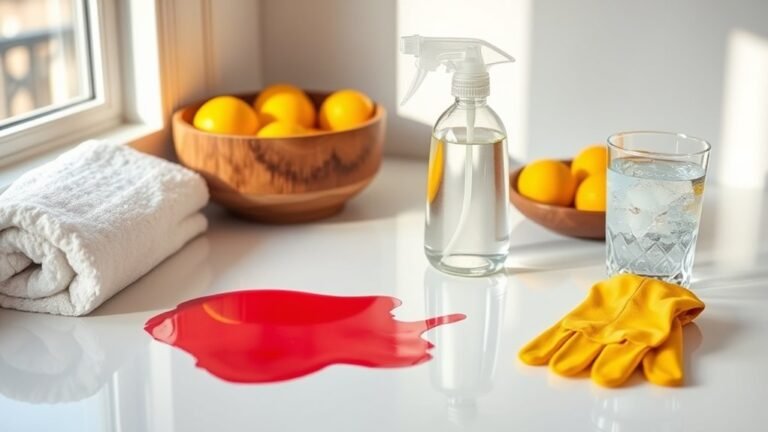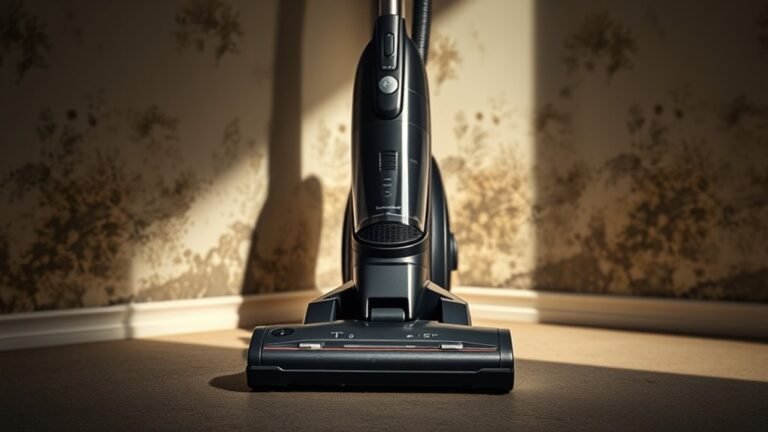How to Clean and Organize Your Junk Drawer
To clean and organize your junk drawer, start by gathering supplies like trash bags and containers. Empty everything out and sort items by type, then discard what’s broken or expired. Group similar items together and choose organizers like dividers or small bins to keep everything neat. Arrange items thoughtfully for easy access, and keep up with regular maintenance to prevent clutter from building again. If you want tips on selecting the best storage solutions, there’s more to explore ahead.
Gather Your Supplies

Before you plunge into cleaning your junk drawer, gather a few essential supplies to make the process smoother. Having a well-prepared supplies list guarantees you won’t get sidetracked or frustrated halfway through. Start with basic essential tools like a trash bag for discards, small containers or trays to separate items, and a microfiber cloth for wiping down the drawer. You might also want a notepad and pen to jot down anything you need to remember or replace. Optional but helpful supplies include labels and markers to organize items later. By assembling these essentials before you start, you set yourself up for a more efficient and freeing experience, turning chaos into order with ease and confidence. Freedom begins with preparation.
Empty and Sort the Contents
Start by taking everything out of your junk drawer so you can see exactly what you have. Next, group the items by type, like batteries, pens, or tape. This sorting step makes it easier to decide what to keep and where to put it.
Remove Everything First
To tackle your junk drawer effectively, the best move is to take everything out at once. This clears your space and gives you a fresh start, freeing you from the clutter that’s been holding you back. Begin by:
- Laying out all items so you see everything clearly.
- Identifying your junk drawer essentials—those must-have tools and items you truly need.
- Discarding or relocating anything that doesn’t fit your vision of an organized space.
This step is vital in any cleaning strategy because it breaks the cycle of chaos. When you remove everything first, you gain control and can decide what deserves to stay. Embracing this freedom allows you to create a drawer that’s both functional and clutter-free, making future organization effortless.
Categorize by Item Type
Once you’ve cleared your drawer, sorting items into categories like tools, stationery, and miscellaneous will make it easier to organize and find what you need later. Start by identifying your drawer essentials—those must-have items you reach for regularly. Group similar things together, such as pens, tape, batteries, or small gadgets. Creating clear item categories helps you see what’s truly necessary, freeing you from clutter and chaos. This approach not only streamlines your drawer but also gives you control over what stays and what goes. By categorizing thoughtfully, you’re setting yourself up for a system that works effortlessly, letting you grab what you need without digging through piles. Embrace this step as a key to reclaiming your space and your time.
Declutter and Discard Unnecessary Items

Now that you’ve sorted everything, take a closer look at each item and decide if you really use it. Toss out anything broken or expired to avoid clutter. Set aside things in good condition that you no longer need for donation or recycling.
Sort Items by Use
Although it might feel overwhelming at first, sorting your junk drawer by how often you use items will make the process much easier. Paying attention to item frequency and usage patterns helps you keep what truly matters within reach. Here’s how you can approach it:
- Daily use: Place items you grab every day up front, like scissors or tape.
- Weekly use: Store things you need less often but still regularly, such as batteries or glue sticks, toward the middle.
- Rare use: Items you seldom touch—like specialty tools—can go in the back or a separate container.
This system frees your space and your mind by making sure only the essentials are easily accessible, helping you maintain order and enjoy the freedom of a clutter-free drawer.
Identify Expired or Broken
A key step in organizing your junk drawer is identifying expired or broken items to declutter effectively. Start by pulling everything out and checking expiration dates on things like batteries, adhesives, and medications. Expired items not only clutter your space but also hold you back from feeling truly free and in control. Next, test tools and gadgets; broken tools that no longer work only weigh you down and create unnecessary frustration. Don’t hesitate to set aside anything that’s cracked, rusted, or missing parts. By clearing out expired items and broken tools, you free up space and energy for what truly matters. This simple act of letting go is empowering, turning your junk drawer into a streamlined zone of order and ease.
Set Donation and Trash
Once you’ve sorted through your junk drawer, it’s time to decide what to keep, donate, or toss. This step is crucial to reclaim freedom from clutter. Follow these three guidelines:
- Donation Guidelines: Check local charity rules to verify your items are acceptable. Only donate things in good condition to make a positive impact.
- Trash Disposal: Separate hazardous materials like batteries or electronics for proper disposal. Use your community’s trash disposal resources to avoid harm.
- Final Review: Before discarding, ask yourself if each item truly serves a purpose or joy. If not, let it go.
Categorize and Group Similar Items

Because clutter can quickly become overwhelming, you’ll want to start by categorizing and grouping similar items together. This step frees you from chaos and makes it easier to find what you need. Begin by identifying clear item categories—think of things like writing tools, batteries, or paper clips. Next, create similar groupings within these categories so everything that belongs together stays together. This simple system helps you see exactly what you have and what you might be missing. By sorting this way, you regain control over your space, making your junk drawer a tool for freedom instead of frustration. The better you group, the less time you waste searching, giving you more freedom to focus on what really matters.
Choose Organizers and Storage Solutions
Grouping your items is just the beginning of taming your junk drawer. To keep everything easily accessible and clutter-free, you’ll want to choose the right organizers and storage solutions. Consider these three steps:
- Use adjustable drawer dividers to create custom sections, so each item has its own dedicated space.
- Grab small storage bins for loose items like batteries, coupons, or pens, preventing them from rolling around.
- Opt for stackable containers if you need to maximize vertical space and keep similar items grouped but separated.
Arrange Items Neatly in the Drawer
Start by placing your most frequently used items within easy reach to save time and effort. Use drawer dividers to create defined spaces, preventing everything from mixing together. These dividers help you categorize items like pens, batteries, and tape, making it easier to find what you need quickly. Incorporate storage bins for smaller or oddly shaped items; they keep things contained and prevent clutter from creeping back in. Arrange everything with purpose—group similar items and leave some breathing room for easy access. By doing this, you’re not just tidying up; you’re reclaiming control over your space, freeing yourself from the chaos that junk drawers often bring. A neat drawer invites calm and efficiency every time you open it.
Maintain Your Organized Junk Drawer Regularly
To keep your junk drawer from slipping back into chaos, you’ll need to maintain it regularly. Regular maintenance guarantees your space stays functional and clutter-free, giving you freedom from frustration. Make drawer check ups a simple habit by:
- Setting a monthly reminder to revisit the drawer, removing items you no longer need.
- Quickly wiping down the drawer’s interior to keep it clean and inviting.
- Rearranging contents as necessary to accommodate new essentials without overcrowding.
Häufig gestellte Fragen
How Often Should I Deep Clean My Junk Drawer?
You want order, you want clarity, you want freedom from clutter. When it comes to junk drawer frequency, aim for a deep clean every three to six months. Setting a consistent cleaning schedule helps you avoid the chaos and keeps your space functional. By sticking to this routine, you’ll enjoy a clutter-free environment without feeling overwhelmed. Remember, regular attention means less stress and more freedom to focus on what matters.
What Are Eco-Friendly Disposal Options for Junk Drawer Waste?
When you’re clearing out clutter, think about recycling options for items like paper, plastic, and metal—you’ll free yourself from waste guilt while helping the planet. For organic scraps or compostable materials, start a compost bin or find a local community compost program. This way, you keep trash out of landfills and embrace a lifestyle that values freedom and responsibility. Choosing eco-friendly disposal means you’re taking control and making a positive impact.
Can I Use Digital Tools to Track Junk Drawer Items?
Absolutely, you can use digital inventory and organization apps to keep track of your junk drawer items. These tools give you the freedom to quickly note what you have, where it’s stored, and when you last used it. By using apps, you reduce clutter in your mind and physical space, making your life simpler and more efficient. It’s a smart way to stay organized without feeling tied down by traditional methods.
How Do I Prevent My Junk Drawer From Becoming Cluttered Again?
You might think keeping your junk drawer organized is impossible, but it’s all about consistent effort. To maintain clutter prevention, set a quick weekly reminder to tidy up and put things back in their designated spots. Use small containers or dividers to enhance junk drawer organization, making it easier to find what you need. By staying committed, you’ll enjoy the freedom of an orderly space without the stress of chaos creeping back in.
What Are Alternative Places to Store Commonly Misplaced Items?
You can free yourself by ditching the junk drawer for some alternative spots. Think about item categorization—store batteries in a small container in your office, keep scissors and tape in a craft box, and place frequently used tools in a wall-mounted organizer. Drawer organization isn’t just about one spot; spreading items out based on their use helps you find what you need faster and keeps clutter from taking over again.






